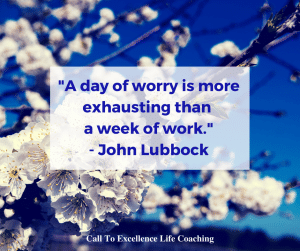
I suppose I shouldn’t have been surprised when I suffered from a touch of insomnia right as I started working on this post. I mean, what’s more fitting than staying up all night worrying about writing an article on worry?
As I tossed back and forth (earning an annoyed glance from my cat each time I cut into his 20+ hours of beauty sleep to boot), thoughts looped through my brain like one of those never-ending news tickers on the bottom of the TV screen. What if I can’t think of anything to write? What if I don’t finish before my self-imposed deadline? What if no one reads it? What if a lot of people read it and it’s complete gibberish? What if my cat takes revenge on me for keeping him up all night too?
What if…? What if…? What if…?
Notice how nothing good ever follows those two words when we’re in the grip of worry?
That’s because worry is a very specific, habitual, thought pattern. According to Ellen Hendriksen, PhD, a clinical psychologist at Boston University’s Center for Anxiety and Related Disorders and host of the Savvy Psychologist podcasts, worry stems from two specific mindsets: first, a certainty that something bad is going to happen, and second, that we won’t be able to handle it. (1)
While my example above isn’t very serious, and maybe even a little humorous, it does illustrate both of these mindsets, and the way this thought pattern can hijack our brains. Importantly, this basic thought pattern is the same regardless of how trivial or serious our situation or concern is.
Your Brain on Worry
At best, worry is a costly nuisance. Our conscious mind can only focus on one thing at a time, so when we worry, it distracts us. We can’t concentrate on our work, or the activity we’re involved in, and our performance suffers. Nor can we be fully present to the people around us, so chronic worrying can affect our relationships, too. And because the more primitive part of our brain can’t tell the difference between a real and an imagined event, worry triggers the fight-or-flight response, flooding our body with stress hormones which shut down our creative and cognitive functions, the very abilities we need to find a solution to the situation causing us to worry in the first place. At the extreme, a lifestyle of chronic excessive worrying can lead to stress-related health problems and reduce our quality of life.
We all know intuitively that worry isn’t good for us, and most people probably want to worry less, rather than more. But is this habit hard-wired into our brains, or is there something we can do to change it?
To some degree, we are evolutionarily programmed to see the world as a threatening place – after all, our cave-people ancestors wouldn’t have lived long if they assumed everything rustling in the underbrush was a cute little bunny rather than a hungry saber-toothed tiger. However, I’m going to assume that if you’re reading this, you’re not in immediate physical danger every time you walk out your door. Therefore, being on constant hyper-alert is no longer essential, and can even be counter-productive.
Thankfully, over the eons our brains have also developed a greater capacity to think about and process information. Part of that capacity includes the ability to become aware of our own thoughts, and this ability gives us a valuable tool to deal with worry. The first step is simply awareness. While we may fall into a loop of worry out of habit, or be triggered by an upsetting situation, once we become mindful of the fact that we’re worrying, we begin to have options to take back control of our brain.
Question Your Underlying Assumptions
One key to keeping worry in check, Hendriksen says, is to challenge those underlying beliefs. How likely is it that your worst-case scenario will actually happen? Susan Jeffers, PhD, author of Feel the Fear… And Do It Anyway, cites reports that suggest that “more than 90% of what we worry about never happens.” (2) Most people would never consider investing in a business that had less than a 10% chance of success, yet we invest enormous amounts of mental energy on imagined worst-case outcomes with about the same odds of coming true.
We also need to challenge the underlying belief that we’re helpless and unable to handle the scenarios we’re imagining. Hendriksen recommends brainstorming all the possible resources available to you, including your personal skills and strengths, as well as those of friends and family. Get more information, prepare, and come up with Plans B, C, and D. Review situations from your past when you’ve stepped up to a challenge and handled in it. Recognize that you have the strength and ability to handle the situation in front of you.
Objectively Analyze Your Worry
This next strategy, called the “Worry Buster”, comes from Brian Tracy, a leading authority in sales training, author/speaker, and overall success guru. (3)
Step one is to write down what it is you’re worried about. Although this sounds simplistic, many times we’re not even clear what it is we’re worried about, just some ambiguous negative scenario in the future. According to Tracy, this step alone will resolve about 50% of our worries: “many of our worries exist because we have not taken the time to sit down and really define clearly what it is that is bothering us.”
Step two is to write down the worst possible outcome, and Step 3 is to resolve to accept this outcome, should it come to pass. Much of our stress and worry comes from resisting an undesirable outcome or scenario. Note that this acceptance doesn’t imply passivity or giving up, but simply a deep knowing that if the worst happens, you can and will handle it. You’re letting go of the fear and resistance.
Step 4 is about taking a proactive, productive stance. Begin to brainstorm how you can reduce the chance of the worst-case scenario from happening, or minimize the impact if it does happen. Find some small step you can take immediately, and get busy. Taking productive action puts you back in the driver’s seat of your life – you can’t control other people or external events, but you can control your reactions, and how you play the cards you’re dealt.
Create a Designated Time for Worry
This strategy takes advantage of our natural talent for procrastinating. I’ve seen different versions of this strategy over the years, but essentially, you pick a time either daily or weekly to be your designated time for worrying. Allow yourself 30 – 60 minutes per session. Put it on your calendar or in your planner, whatever you need to do to make sure this time is reserved and inviolable.
Next, whenever something to worry about comes to mind during your day or week, write it down. Writing is crucial with this technique – it’s not enough to try to just put it out of your mind – you need to reassure your brain that you’ve captured this valuable piece of information someplace safe so it can let go of it. Capture just enough detail so you’ll be able to return to your train of thought later, but don’t spend a lot of time analyzing your worry at this point. Just make a quick note, and then store it away – you could have a notebook dedicated for this purpose, or a special container for storing your worry notes.
At the designated time, pull out your stockpile of worries, set a timer, and worry your little heart out. Likely you’ll find many of the things you were worried about have already resolved themselves. For the ones that still require a solution, you can now give them your undivided attention.
Concluding Thoughts
I’ve focused here on strategies that tackle worry head-on, but there are other approaches that involve interrupting the pattern of worry and distracting ourselves in healthy ways. Examples include exercising, meditation, immersing ourselves in an absorbing hobby, or getting involved in an activity where we’re giving to others rather than thinking about ourselves. The best advice? Try several different approaches until you find the one that works best for you, and recognize that different approaches may work better at different times or for different situations.
And, whatever happened with my worries about writing this article? Well, I don’t know yet about readers and their reactions, but my cat has not yet taken revenge, so that’s one worry that never came to pass. And I did manage to finish this article and post it before my self-imposed deadline. Interestingly, that came about because of a little twist I tried.
Instead of asking the question, what will happen if I DON’T meet my deadline, I asked the opposite question: what will happen if I DO meet my deadline? And I realized that this would help build a track record of success with myself, which would build a foundation of confidence that will serve me well in the future in my writing career. That was much more inspiring, enough that I was able to stop worrying, sit down, and focus on getting it done.
And here it is 🙂
Your Turn:
How does worry affect your life? Do you have any other strategies or resources you find helpful? Please share in the comments below!
References:
(1) Hendriksen, E. (June 30, 2016) 2 Ways to Stop Worrying and Overcome Anxiety – Questions you have to ask yourself when thoughts start to spin out of control. Retrieved from: https://www.psychologytoday.com/us/blog/how-be-yourself/201606/2-ways-stop-worrying-and-overcome-anxiety
(2) Jeffers, S. (1987, 2007) Feel the Fear… and Do It Anyway New York, NY: Ballantine Books.
(3) Tracy, B. Stop Worrying! Powerful Ways of Overcoming Fear. Retrieved from: https://www.briantracy.com/blog/personal-success/powerful-techniques-to-overcoming-fear-and-stop-worrying/







16 thoughts on “Clearing Mental Clutter: Kicking Worry to the Curb”
This was an excellent post so you have nothing to worry about in regards to quality! Love your current time suggestions for dealing with worry. And as a long time worrier (I’m 63 now) who only figured out how to walk away from worrying only a couple years ago I have one final clincher for you to add to the arsenal: If you look back on all the things you did worry about all these years, you’ll notice that most of the ones that you can remember…..never came true. So you can actually see how much of your life and energy you wasted.
Thank you! That means 0 out of 5 of my worries came true – I lost sleep for nothing 🙂 And what an amazing insight and perspective – you’re right, as I think back over my life, very few of my worries came true, and even if they did, I handled it and things worked out for the best in the long run – I suspect most of us have had the same experience – thanks so much for sharing that way of looking at it!
I started reading this book titled ‘the miracle morning’.it enabled me to see the power of the affirmations we make over our lives and how they manifest. Although I would call myself a worrier, I don’t want to do that anymore. I want to take actions instead. So now, I tell myself that I am not a worrier because sometimes I lose productivity for up to 2 days when I go down the lane of worry. I am working towards it and your post will help a lot. Thank you
Thank you! I can so relate to your experience – I’ve lost days of productivity worrying about the most senseless things too. The good news is that we can train our minds to stay focused on more positive, productive things. Like any new habit, it takes time, but you are on the right track with the affirmations and taking action – good work, and keep it up! 🙂
Thank you for your kind words 🙂
“More than 90% of what we worry about never happens.” I really need to remember this. For the last week I’ve been worrying about a tough conversation I was going to have to have at work. Endured so many sleepless night. I had the conversation yesterday and while it wasn’t fun, it was no where near as bad as I was preparing for.
🙂 That’s almost always the way things turn out – our imaginations are sooo much more creative than the real world. Maybe turn that quote into a sign and hang it somewhere to remind yourself of that fact when you find yourself getting sucked into the worry cycle 🙂
Personally I have this reminder that I’ve kept for years now… I was attending a spiritual retreat and the speaker said. IF YOU WORRY, PRAY. IF YOU PRAY – DON’T WORRY. And so I keep it in my heart <3
That is a great reminder – glad you found a way to keep worry away 🙂
Most of the things we worry about are complete nuisance. I liked your suggestion on designating some time for worrying. Would like to try it.
Thanks Devendra! Give it a try – it’s kind of fun, when you put off your worries until a designated time, and then pull them out – most of them seem silly once some time has relapsed – and the worries that are real can then get your undivided attention, and you can focus on solutions 🙂
Enjoyed reading your thoughts on dealing with worry….most of the time we worry on things which actually hardly matter..
Thank you
So true Krish! Far better to put our mental powers to work on something that DOES matter 🙂
That’s true.
God bless you
Very helpful article. I too write about anxiety, only from the perspective of a parent with an anxious child. Your suggestions are easy to use in the quiet of your home. The website it soothing and relaxing. I will continue to follow.
Thanks Colleen! I’m interested in seeing your writing too, to learn what techniques you’ve found effective, and whether there are differences in anxiety between children and adults.